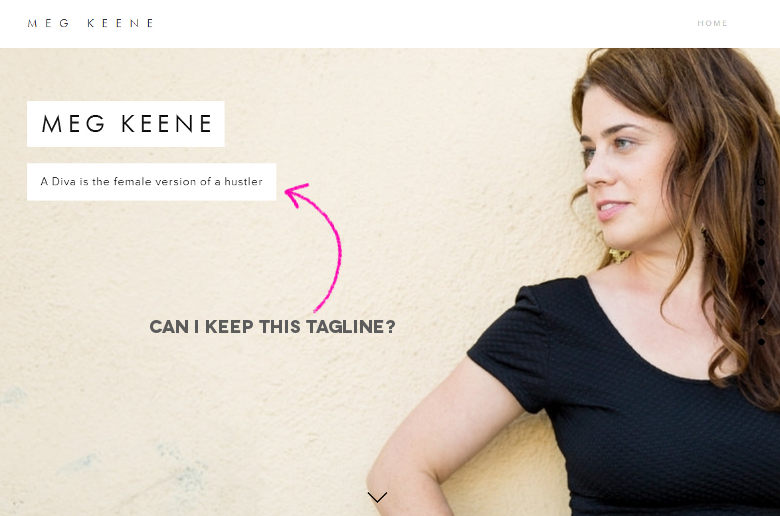

Raise your hand if all of your professional self-promotional tools are in great shape right now. Your resume is up to date, your online profiles are polished, and for those of you who are writers/entrepreneurs/freelancers, your personal portfolio website makes you look like the best in the business.
Why are there no hands up?
Oh right. Because self-promotion is a particular kind of hell on earth. Particularly, I’d argue, if you’re a woman. As women, we’ve spent a lifetime learning to not show off, to keep our heads down, to fit in with the pack and not toot our own horns. The trouble is, to get ahead in our careers, we have to be willing to sell ourselves. We have to be able to write a killer resume, or talk about our strengths in an interview. And in the current world, we need to be in control of our professional persona, in the form of our digital footprint.
I’m the cobbler’s child
Here is the thing about an online profile: I don’t have one. Not really. If you Google my name, you do get a page of results (which I’m grateful for). You get my author page on APW, a Twitter account I barely use, and a whole bunch of press about that book I wrote. You can get a pretty clear idea of what I’m doing professionally, if you piece it all together. You can even figure out that I’m into politics and the Oscars, if you care enough to look. But the problem is, none of what you see is crafted with any particular intention by me. This is particularly absurd, because I spend a good part of my professional life at APW consulting with small business owners (our advertisers) to help them shape their online profiles. The cobbler’s children have no shoes indeed.
Why is that? Well, I have the perpetual excuse that I have APW to run, so I’m busy. But the real truth is that I find it hellish to write about myself, and my accomplishments. I’m uncomfortable using the word “accomplishments” in a sentence, which is how bad it is. And I find it downright embarrassing to put my bio and resume right out there on the Internet… where everyone can see it. I’m pretty sure I’m not the only one.
There is only one way that I am able to sell myself, and that’s when I give myself a deadline. So when Squarespace wanted to team up with us to talk about their platform that allows you to build easy, stylish websites, I promised them that I’d create my portfolio website on their platform. I needed a deadline. (If you need a push too, Squarespace is offering 10% off yearly website subscriptions to all APW readers; details on that are at the end of the post.)
Next month, I’ll (gulp) actually launch my new site, but after spending a lot of time working on my it, this month I wanted to talk about simple steps you can take to set up a portfolio site. Because while I’ve put off doing this for myself for years, I’ve spent those same years consulting with other women about setting up their own online profiles.

1. What Are you selling?
The key to building a successful portfolio site is figuring out what you’re trying to sell. Of course, the short answer is, you’re selling yourself. But let’s not fall into the trap of the personal brand. You don’t have to sell every aspect of who you are (or share every part of your online life). In this spot, you’re working to shape an image of the professional you are and the kind of work that you do.
You can include a few kinds of related work under one professional umbrella, but be cautious before you include too much. If I want to hire you as a technical writer, and you have a section on your site for your knitting projects, I’m going to be confused about who you are, professionally. The knitting projects can exist online, but they should have their own space.
That said, if you do different kinds of work that are all related, your job is to present those different skills in a unified way. I’m balancing the identities of writer, editor, entrepreneur, and teacher. Since I’m not looking to get hired in a particular area, I’m trying to find a way to present an overarching sense of the different things I do, and the way they are all related.
2. What do other portfolio sites in your field look like?
This is where it gets fun (and where you get a excuse to procrastinate a little bit). It’s hard to envision what your website should look like till you take a glance at how other people in your field are setting up their sites. Here, you should be looking both at content and form.
I recently consulted with APW contributor Rachel as she relaunched her own site. So I asked her for suggestions of awesome sites by women writers and editors. When I researched, what I found was a lot of smart content (Writers! Go figure!), and a lot of sites that I frankly wished had been built with the professionalism of Squarespace. I live in the world where publishing and writing meet. That means I want your website to look real pretty, because I know you have the tools. But, during my research I also found a lot of awesome, and I wanted to share the best of the best. So for your procrastinating pleasure professional research here is my short list:
- Nona Willis Aronowitz’s site has a near perfect structure.
- A beautiful clips page from Tracy Clark-Flory
- Ann Friedman’s clips are so well selected that I could spend an hour reading everything on her page. The proof is in the pudding. Don’t post everything, post your best stuff.
- While we’re on the subject of Ann Friedman, after you’re all intimidated by her work (Good job, website. That’s the goal) her FAQ with .gifs should cheer you right up.
- Also, look! She does a tiny letter, a.k.a. a (tiny) newsletter. Smart.
- If you’re pitching yourself as a smart, feminist, women’s writer, there is clearly a place for awesome .gifs. I should get on that.
- Jess Bennett has an excellent example of what a list of things you edited can look like. Helpful, for those of us who feel like calling out our editing is cheating, because it’s the uncredited (if all-consuming) part of our job.
- If you’re going to have a blog on your site at this point, you might as well follow Jessica Valenti’s lead, like so.
3. Picking a visual style: dress for the job you want
It’s easy to fall into the trap of thinking that if you’re putting a portfolio site together yourself, it’s going to look boring. And that’s how it used to be. Not so long ago, if you were building a website for yourself, chances are you were trying to create some sort of hacked website. If you could get the site to reasonably convey your basic information, you figured you’d won the day.
No more. These days, you can use Squarespace to create a site polished and professional enough to compete with the best. With them, you can even hook up a custom URL to your site with no fuss and no bother. Squarespace’s tools are relatively easy to use. And if after a few rounds of playing around (for me, the third time was the charm), and using their excellent customer service, you’re still not getting it, ASK SOMEONE FOR HELP. The great thing about Squarespace, is they give you user friendly enough tools, that you can bribe your friend/partner/dog walker to help you. We’re not all good at everything, and that’s okay.
Because you have the tools (and no excuses), you need to figure out how you want to visually present your image. As someone who wants her professional work to be focused on pushing boundaries, I realized that my site needs to present as trend aware. Because of that, I picked the Marquee one page scrolling template. I’m still not sure how I feel about the new one page scrolling websites, but they are undeniably the front line of what’s happening in web design right now, and that’s part of the image I want to present.
This is a case of dressing for the job you want, not the job you have. What work do you do? What work do you want to do? If you mostly work writing freelance articles about beauty products, but want to be writing feminist think pieces, your portfolio site is the place to project that image. And that image starts visually.
4. Structure your site
I’m the kind of person who always wrote a detailed outline before she wrote a term paper (and now writes a detailed chapter outline before she writes a book). I find it helpful to set up a structure and then fill in that structure with words and pictures. So first up, I recommend figuring out what each of the pages of your site are going to be. Get ideas from your research sites, come up with an outline, and then check with a friend.
I’d originally decided to divide my site up this way: bio, APW, book, writing, speaking, press. But I ran it by a friend, who pointed out that my editing work deserved its own section. (Something that never would have occurred to me.) So come up with your outline, and then run it by a few smart people.
5. Start writing your copy
Have I mentioned that I find writing about myself hellish? I do. And I’m pretty sure I’m not alone on this. So here is my recommendation. Write a rough draft of your copy, and then hand it off to someone who knows and respects your work. Bribe with cookies, and let them write some copy about how awesome you are.
You know what’s fun? Writing about how awesome your friend is. You know what’s awful? Writing about how awesome you are. So trade favors, kids.
6. Figure out what you want to include
Remember when we all were supposed to have a personal brand? Yeah, that was a hellish experiment that I think has finally died an ugly death. So keep this in mind: you are not a brand (though you might have a brand). And what you do, and who you are, are not the same. This, blessedly, allows you to set appropriate limits around how you choose to present yourself to the world. Just because you’re married with a baby (me), or like confetti (also me), does not mean that you have to include these things as part of your professional persona.
In a world where we all have a lot of online outlets, your job is to decide what you want to include. Plenty of women writers include links to their Twitter or Instagram on their websites. For the moment, I’ve opted not to. I have an Instagram account where I occasionally document snapshots of my life as a writer/editor/wife/mother/lover of confetti. And while it’s not a private account, it also doesn’t have much to do with my professional life. I’m fine with the fact that people might stumble on it, but I don’t want to include it as part of my intentional, professional image.
7. (and no, you don’t need a blog)
When I chat and consult with people about their professional websites, the idea of the blog invariably comes up. We went through a period in 2007–2010 where the smartest thing you could do for your business was to have a blog. The problem is, maintaining a blog is a ton of work. If you’re trying to update your blog a few times a week with new work, and network with other bloggers, you are looking at a huge time suck (and you better love it).
But now it’s 2014, and I’m here to tell you that you don’t need a blog anymore. Or, more precisely, you don’t need a regularly updated blog. You probably need to find a corner of the Internet to update and interact with people regularly. What tool you use is going to depend on your industry, and it’s going to change. (For me it used to be Twitter. Now, it’s mostly Instagram.) If you sell a product or like sending monthly updates on your business, that could be an email newsletter—one that you can then turn into a blog post, rather than wracking your brain for extra blog content. But almost every social tool is less time consuming than blogging just for the sake of it, so you’re welcome.
If you do have a blog on your portfolio site, it’s perfectly acceptable to use it as a place to collect your work that’s appearing in various places around the web, and to provide news updates. Think of it as a hub for content you’re producing elsewhere and a spot for news, not a place where you need to share daily updates on your life. (That’s what Instagram and Twitter are for, if you care.)
Finally, A Note
When putting together your portfolio site, you’re going to feel like an impostor. You may feel particularly awful during the part where you’re doing your research, because clearly everyone is so much more accomplished than you, WAAAHHH. This is normal. Wallow in it, if you need to. Pour yourself a glass of wine, and wonder about what you’re doing with your life. Then, get your shit together, and do not allow your impostor syndrome to show in your work. Nobody wants to read a website of someone tacitly apologizing for not being, somehow, better. No one wants to sit next to that person in a bar, either. Instead, we just want the facts on who you are and what you do, so we can imagine the awesome things you might do in the future (possibly with us).
You don’t have to believe it to put it on your website. Trust me when I say, basically nobody does.
Some impostors have bad websites. Most of them have no websites. But some impostors have amazing websites. Make yourself one of the latter.
On to you APW. What are your struggles in promoting yourself? What are you working on to make yourself look like the best in your business? And if you have a portfolio site, share it in the comments, we want to see!

This post was sponsored by Squarespace. Thanks Squarespace for helping make the APW mission possible! SQUARESPACE IS OFFERING 10% OFF YEARLY SUBSCRIPTIONS TO ALL APW READERS. JUST USE THE CODE APW14 AT CHECKOUT! CLICK HERE TO START your 14-DAY FREE TRIAL.






